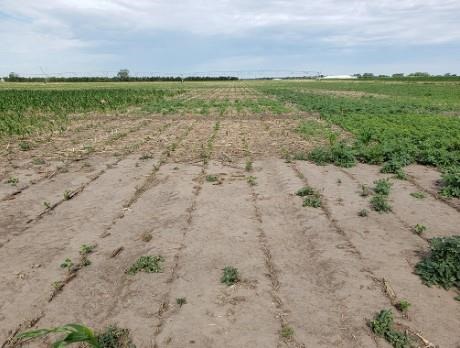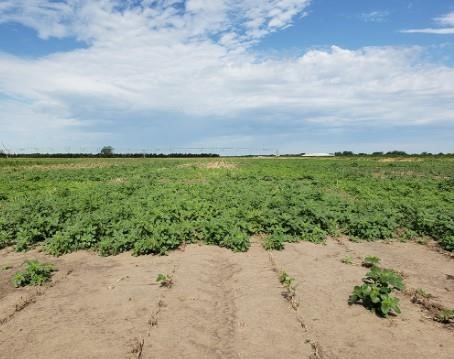By Amit Jhala and Jenny Rees et.al
Hail and windstorms in Nebraska damaged canopy in corn and soybean (Figure 1). Weed emergence can occur in canopy gaps. Of particular concern is Palmer amaranth (Figure 2) and waterhemp because new emergence of these weeds is possible until end of August. If left uncontrolled, it could result in yield loss, harvest problem and contribute significantly to weed seed bank. The majority of soybean fields were applied with a pre-emergence herbicide at planting; therefore, post-emergence herbicide is an option for weed control in storm-damaged soybean. Inter-row cultivation is possible if grower has equipment, wide enough row spacing and experience.

Figure 1. Significant damage in a south-central Nebraska soybean field due to hailstorm. (Photo by Amit Jhala)
Figure 2. Palmer amaranth emergence in a hail-damaged soybean field. (Photo by Amit Jhala)It is important to consider soybean growth stage or pre-harvest interval when applying post-emergence herbicides to avoid potential crop injury. Herbicide product labels provide a maximum soybean growth stage after which broadcast herbicide applications should not be made (Table 1). When using an herbicide tank-mixture, follow the recommendations for the most restrictive label language of products being used in the mixture. Note that dicamba-based herbicide such as Engenia, Tavium or XtendiMax cannot be applied after June 30, 2022 or their respective soybean growth stage (Table 1), whichever comes first.
Table 1. Application restriction of post-emergence herbicides commonly applied in soybean.| Herbicidea,b | Crop Height Limit or Pre-harvest Interval (PHI) |
|---|
| Arrow | 60 days, PHI |
| Assure II | Not after pod set, 80 days PHI |
| Basagran | 30 days for forage or hay |
| Cadet | Full flower or 60 days PHI |
| Classic | 60 days PHI |
| Cobra | 45 days PHI |
| FirstRate | Bloom to 50% flowering, 65 days PHI |
| Engenia (only for Roundup Ready 2 Xtend soybean) | Do not apply after June 30 |
| Enlist ONE (only for Enlist soybean) | Before Bloom |
| Enlist DUO (only for Enlist soybean) | Before Bloom |
| Extreme | Prior to flowering |
| Flexstar GT | Bloom |
| Fusilade | Bloom |
| Fusion | Bloom |
| Glyphosate | Consult specific label, generally through R2 |
| Harmony SG | 60 days PHI |
| Liberty (only for Liberty Link or Enlist or XtendFlex soybean) | Bloom |
| Marvel | Up to R3 or 60 days PHI |
| Phoenix | 45 days PHI |
| Pursuit | Prior to flowering |
| Raptor | Prior to flowering |
| Reflex/Flexstar | Bloom |
| Resource | 60 days PHI |
| Roundup PowerMAX | Consult label, generally full bloom (R2); harvest aid, 7 days PHI |
| Scepter | 90 days PHI |
| Select MAX | 60 days PHI |
| Tavium | Up to June 30 or V4 |
| Targa | Podset, 80 days PHI |
| Ultra Blazer | 50 days PHI |
| Warrant | R2 |
| Warrant Ultra | R1 |
| XtendiMax (only for Roundup Ready 2 Xtend soybean) | Up to June 30 or R1 |
a When using an herbicide tank-mixture, follow the recommendations for the most restrictive label language of the product being used in the mixture.
b Use labeled adjuvants with post-emergence herbicides. Refer to 2022 Guide for Weed, Disease, and Insect Management in Nebraska.Residual Herbicides in Post-emergence Application
A few residual herbicides such as Anthem, Dual II Magnum, FirstRate, Outlook, Prefix, Pursuit, Warrant, Warrant Ultra and Zidua can be applied after soybean emergence. Some of these herbicides such as Anthem, FirstRate (only for broadleaf weeds), Pursuit and Prefix have foliar activity to control small, emerged weeds.
Given most soybeans grown in Nebraska are glyphosate-resistant, glyphosate can be tank-mixed with residual herbicides with no foliar activity, such as Dual II Magnum, Warrant or Zidua to control weeds already emerged at the time of application. Glyphosate will not control glyphosate-resistant weeds so consider an additional herbicide with foliar activity depending on soybean trait planted. For example, dicamba (Engenia, XtendiMax or Tavium) can be applied in Roundup Ready 2 Xtend soybean. Enlist ONE or Enlist DUO can be applied in Enlist soybean. It is also possible to tank-mix some other post-emergence soybean herbicides such as Cadet, Classic, Cobra, Flexstar GT, Fusilade DX, Ultra Blazer and Select Max, depending on emerged weeds to be controlled. This would add a different mode of action and might effectively delay or control glyphosate-resistant weeds.
Some factors should be considered when addressing weed control with residual herbicides applied after soybean emergence:
- Soybean growth stage
- Tank mix partner
- Weed growth stage
Following is more specific information for residual herbicides that can be applied after soybean emergence.
Anthem is a pre-mix of Zidua (Pyroxasulfone) and Cadet (Fluthiacet-methyl). It can be applied post-emergence in soybean up to the V3 stage. The application rate is in a range of 4 to 9 fl oz per acre depending on soil type. It provides effective residual activity for control of common waterhemp, Palmer amaranth, common lambsquarters, velvetleaf, and grasses.
Dual II Magnum can be applied at a rate of 1 to 1.33 pints per acre as a post-emergence treatment to soybeans from emergence up through the third trifoliate leaf stage. Dual II Magnum will not control emerged weeds, so it must be applied to a weed-free soil surface or in a tank mixture with products that provide post-emergence control of weeds present at the time of application. Do NOT apply Dual II Magnum if S-metolachlor products such as Dual Magnum or Dual II Magnum have already been applied.
FirstRate may be applied any time prior to the 50% flowering stage of soybeans; however, application prior to full emergence of the first soybean trifoliate leaf may cause temporary yellowing or chlorosis of soybeans. Tank-mix partners may cause other effects regardless of application timing.
Pursuit can be applied early post-emergence in soybeans when weeds are actively growing and before they exceed a height of three inches. Apply Pursuit before soybean bloom at an application rate of 4 oz per acre. Base application timing on weed size and not soybean growth stage. Use a crop oil concentrate at 1 gallon per 100 gallons of spray solution.
Prefix can be applied at two to 2.33 pints per acre as a post-emergence application from cracking through the third trifoliate stage of soybeans. Necrotic spotting, leaf crinkling or curling of soybean leaves may occur following post-emergence application, but soybeans soon outgrow these effects and develop normally. Prefix alone may control or partially control some emerged broadleaf weeds; however, for broad spectrum control, tank-mix with other herbicides. Add non-ionic surfactant at 0.25% v/v to the final spray volume. Do NOT use crop oil concentrate when applying Prefix post-emergence as these spray adjuvants may increase soybean injury.
Outlook is a selective residual herbicide for controlling annual broadleaf, grass and sedge weeds. Emerged weeds will not be controlled and must be controlled with an appropriate post-emergence herbicide. Outlook can be applied from emergence to fifth trifoliate leaf stage. The application rates in a single application are 12 to 18 fl oz per acre on course-texture soils, and 14 to 21 fl oz per acre on medium-texture or fine-texture soils. This can also be influenced by soil organic matter content. If Outlook is applied in two split applications, maintain a minimum 14-day interval between applications and do NOT exceed a seasonal total of 24 fl oz per acre.
Warrant is an encapsulated acetochlor herbicide that can be applied post-emergence in soybeans after soybeans are completely emerged, but before they reach R2 (initiation of flowering) growth stage. It can be applied at 1.25 to two quarts per acre, depending on soil texture and organic matter content. The optimum timing and rate of application is when soybeans are V2 to V3 stage at 1.5 quarts per acre. Warrant is a residual herbicide, so it must be tank-mixed with a burndown herbicide to control existing weeds. Warrant Ultra is a mixture of Warrant (acetochlor) with fomesafen and can be applied up to R1 soybean stage.
Zidua SC is a selective, rate-dependent residual herbicide for control of annual grasses, broadleaf and sedge weeds. It can be applied to soybean at first to sixth trifoliate leaf stage. Zidua SC can be applied from Preplant to V6 soybeans with no growth stage restrictions. Use rate of Zidua SC prior to soybean emergence is 2.5-5.75 fl oz depending on soil type. For POST-emergence use in soybeans, Zidua SC has a use rate of 1.5–3.5 fl oz. Zidua has no foliar activity, so it must be tank-mixed with a foliar active herbicide for control of existing weeds depending on soybean trait planted.
Residual Activity
Length and effectiveness of residual activity from in-crop application will vary depending on:
- Weed species.
- Herbicide application rate.
- Rainfall following application (minimum of 0.5 inches of rainfall within 10 days of application is ideal).
- Density of the weed and crop canopy at the time of application.
- Length of subsequent weed germination events.
Herbicide Selection in Replanted Soybean
- If soybean is replanted in hail-damaged field, care should be taken for selecting herbicide because each herbicide has a maximum limit of cumulative amount to be applied in a single growing season. Herbicide label should be checked before selecting herbicides in replanted soybean.
Source : unl.edu